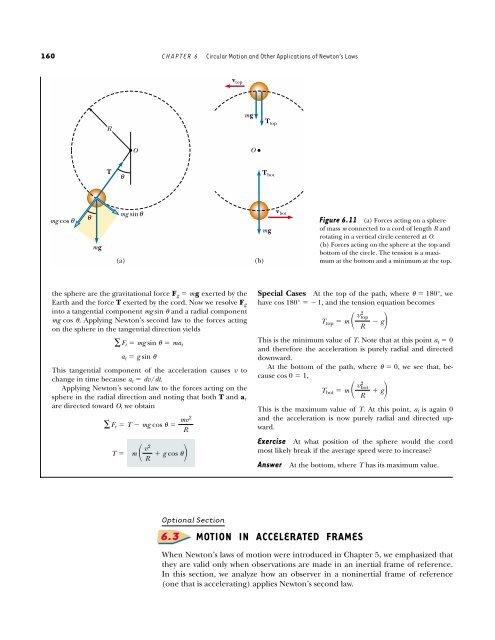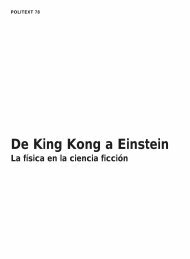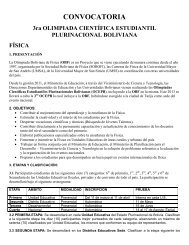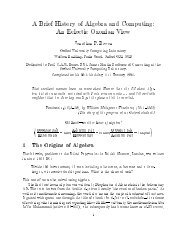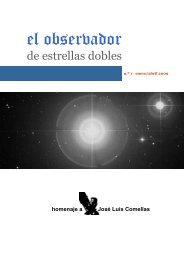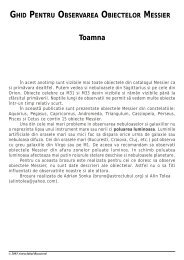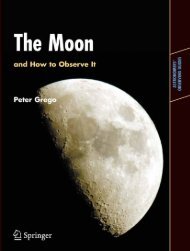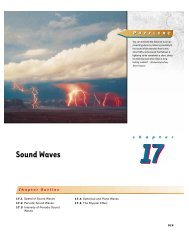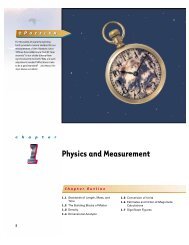Circular Motion and Other Applications of Newton's Laws
Circular Motion and Other Applications of Newton's Laws
Circular Motion and Other Applications of Newton's Laws
You also want an ePaper? Increase the reach of your titles
YUMPU automatically turns print PDFs into web optimized ePapers that Google loves.
160 CHAPTER 6 <strong>Circular</strong> <strong>Motion</strong> <strong>and</strong> <strong>Other</strong> <strong>Applications</strong> <strong>of</strong> Newton’s <strong>Laws</strong><br />
mg cos θ<br />
θ<br />
mg<br />
R<br />
T θ<br />
(a)<br />
the sphere are the gravitational force F g � mg exerted by the<br />
Earth <strong>and</strong> the force T exerted by the cord. Now we resolve F g<br />
into a tangential component mg sin � <strong>and</strong> a radial component<br />
mg cos �. Applying Newton’s second law to the forces acting<br />
on the sphere in the tangential direction yields<br />
�F t � mg sin � � ma t<br />
This tangential component <strong>of</strong> the acceleration causes v to<br />
change in time because at � dv/dt.<br />
Applying Newton’s second law to the forces acting on the<br />
sphere in the radial direction <strong>and</strong> noting that both T <strong>and</strong> ar are directed toward O, we obtain<br />
�F r � T � mg cos � � mv2<br />
R<br />
T �<br />
O<br />
mg sinθ<br />
a t � g sin �<br />
m � v2<br />
R<br />
� g cos ��<br />
Optional Section<br />
6.3<br />
v top<br />
mg<br />
O<br />
(b)<br />
T top<br />
T bot<br />
mg<br />
v bot<br />
Special Cases At the top <strong>of</strong> the path, where � � 180°, we<br />
have cos 180° ��1, <strong>and</strong> the tension equation becomes<br />
T top � m � v2 top<br />
R<br />
This is the minimum value <strong>of</strong> T. Note that at this point a t � 0<br />
<strong>and</strong> therefore the acceleration is purely radial <strong>and</strong> directed<br />
downward.<br />
At the bottom <strong>of</strong> the path, where � � 0, we see that, because<br />
cos 0 � 1,<br />
T bot � m � v2 bot<br />
R<br />
This is the maximum value <strong>of</strong> T. At this point, at is again 0<br />
<strong>and</strong> the acceleration is now purely radial <strong>and</strong> directed upward.<br />
Exercise At what position <strong>of</strong> the sphere would the cord<br />
most likely break if the average speed were to increase?<br />
Answer At the bottom, where T has its maximum value.<br />
MOTION IN ACCELERATED FRAMES<br />
Figure 6.11 (a) Forces acting on a sphere<br />
<strong>of</strong> mass m connected to a cord <strong>of</strong> length R <strong>and</strong><br />
rotating in a vertical circle centered at O.<br />
(b) Forces acting on the sphere at the top <strong>and</strong><br />
bottom <strong>of</strong> the circle. The tension is a maximum<br />
at the bottom <strong>and</strong> a minimum at the top.<br />
� g�<br />
� g�<br />
When Newton’s laws <strong>of</strong> motion were introduced in Chapter 5, we emphasized that<br />
they are valid only when observations are made in an inertial frame <strong>of</strong> reference.<br />
In this section, we analyze how an observer in a noninertial frame <strong>of</strong> reference<br />
(one that is accelerating) applies Newton’s second law.


